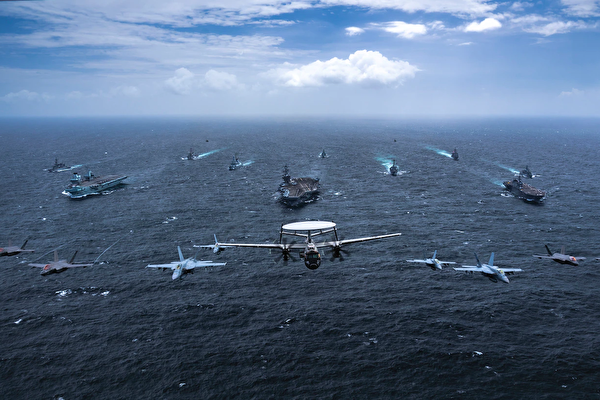Japan and the United States kicked off a 10-day joint military exercise on Wednesday, October 23, with the participation of 45,000 personnel. Just a week ago, China conducted large-scale exercises near Taiwan, drawing condemnation from Taiwan and its main supporter, the United States.
China’s escalating provocations, coupled with the increasingly close defense cooperation between Washington and its allies, have raised concerns about a potential conflict in the Taiwan Strait or other territorial disputes.
According to Japan’s Ministry of Defense, the Integrated Joint Staff Office, the joint exercise named “Keen Sword 25” will involve 45,000 Japanese and American military personnel, 40 warships, and 370 aircraft. Troops from Australia and Canada will also participate.
“Keen Sword 25” is held biennially as a nationwide exercise centered around Kyushu and Okinawa in Japan, and will continue until November 1.
Media reports from Kyodo News Agency indicated that the U.S. Air Force’s F-22 stealth fighter jet, known as the “world’s most powerful fighter,” is participating in training for the first time. The U.S. will deploy six F-22s and around six F-35B stealth fighter jets capable of short take-offs and vertical landings.
On Wednesday, Japan’s Self-Defense Forces showcased joint training with the U.S. military at the Nita Clearing Base in Shin-Tomi Town, Miyazaki Prefecture, Kyushu.
The U.S. Air Force proposed an “Agile Combat Employment” strategy to disperse combat capabilities to multiple bases, and the practical use of the Nita Clearing Base may enhance interoperability with the Self-Defense Forces, as reported by Kyodo News Agency.
The U.S. Indo-Pacific Command stated that around 900 Marines and sailors from the Marine Corps’ III Marine Expeditionary Force will participate in the exercise, conducting joint training with the Ground Self-Defense Force’s Amphibious Rapid Deployment Brigade, including “amphibious assaults,” “humanitarian assistance and disaster relief exercises,” “front-line weapons and fuel supply,” as well as live-fire exercises.
Yoshihide Yoshida, the Chief of Staff of Japan’s Joint Staff, expressed a sense of urgency during a news conference on Tuesday, October 22, emphasizing the need for defense of the Southwest Islands in light of recent incursions by China into Japanese airspace and territorial waters.
“We are determined to prevent and deter serious incidents,” he added, noting the importance of the U.S.-Japan alliance for regional stability.
U.S. Pacific Fleet Commander Steve Koehler stated that the “Keen Sword” exercise will ensure that the U.S.-Japan alliance maintains superiority over forces seeking to disrupt the rule-based international order.
According to Agence France-Presse, a spokesperson for the Japan Self-Defense Forces said that during the exercise, the tilt-rotor aircraft V-22 Osprey will fly to the closest Japanese island to Taiwan, Yonaguni Island, for an “evacuation” drill. The spokesperson added that the exercise aims to simulate evacuating residents and tourists in the event of a natural disaster.
In his first policy speech after taking office earlier this month, Japan’s new Prime Minister Shigeru Ishiba mentioned the crisis in Ukraine and warned of similar security threats facing Asia.
Shigeru Ishiba, who faces a House of Representatives election on Sunday, October 27, supports establishing a regional military alliance similar to NATO, but acknowledges that this goal cannot be achieved overnight.
Earlier on Wednesday, Taiwan’s Ministry of National Defense stated that a Chinese aircraft carrier task group, led by the Liaoning, was passing through the sensitive Taiwan Strait. The day before, Beijing conducted live-fire drills at Niu Shan Island in Fujian Province, just over 100 kilometers from Taiwan.
During last week’s “encirclement of Taiwan” military exercises, China simulated a blockade of Taiwan. Beijing has long claimed democratic Taiwan as part of its territory and has never ruled out the use of force to control the island.
Taiwan’s Defense Minister Chiu Kexian warned that a blockade by China would constitute an act of war and have serious consequences for global trade and economy.
(adapted from Agence France-Presse reports)

